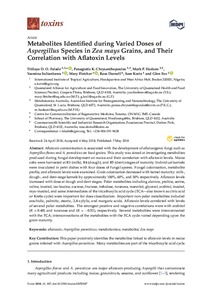| dc.contributor.author | Falade, T. |
| dc.contributor.author | Chrysanthopoulos, P.K. |
| dc.contributor.author | Hodson, M.P. |
| dc.contributor.author | Sultanbawa, Y. |
| dc.contributor.author | Fletcher, M. |
| dc.contributor.author | Darnell, Ross |
| dc.contributor.author | Korie, S. |
| dc.contributor.author | Fox, G. |
| dc.date.accessioned | 2019-12-04T11:21:39Z |
| dc.date.available | 2019-12-04T11:21:39Z |
| dc.date.issued | 2018 |
| dc.identifier.citation | Falade, T.D., Chrysanthopoulos, P.K., Hodson, M.P., Sultanbawa, Y., Fletcher, M., Darnell, R., ... & Fox, G. (2018). Metabolites identified during varied doses of aspergillus species in Zea mays grains, and their correlation with aflatoxin levels. Toxins, 10(5), 1-22. |
| dc.identifier.issn | 2072-6651 |
| dc.identifier.uri | https://hdl.handle.net/20.500.12478/3843 |
| dc.description | Open Access Journal; Published online: 7 May 2018 |
| dc.description.abstract | Aflatoxin contamination is associated with the development of aflatoxigenic fungi such as Aspergillus flavus and A. parasiticus on food grains. This study was aimed at investigating metabolites produced during fungal development on maize and their correlation with aflatoxin levels. Maize cobs were harvested at R3 (milk), R4 (dough), and R5 (dent) stages of maturity. Individual kernels were inoculated in petri dishes with four doses of fungal spores. Fungal colonisation, metabolite profile, and aflatoxin levels were examined. Grain colonisation decreased with kernel maturity: milk-, dough-, and dent-stage kernels by approximately 100%, 60%, and 30% respectively. Aflatoxin levels increased with dose at dough and dent stages. Polar metabolites including alanine, proline, serine, valine, inositol, iso-leucine, sucrose, fructose, trehalose, turanose, mannitol, glycerol, arabitol, inositol,
myo-inositol, and some intermediates of the tricarboxylic acid cycle (TCA—also known as citric acid or Krebs cycle) were important for dose classification. Important non-polar metabolites included arachidic, palmitic, stearic, 3,4-xylylic, and margaric acids. Aflatoxin levels correlated with levels of several polar metabolites. The strongest positive and negative correlations were with arabitol (R = 0.48) and turanose and (R = 0.53), respectively. Several metabolites were interconnected with the TCA; interconnections of the metabolites with the TCA cycle varied depending upon the grain maturity. |
| dc.description.sponsorship | Department of Foreign Affairs and Trade, Australia |
| dc.format.extent | 1-22 |
| dc.language.iso | en |
| dc.subject | Aflatoxins |
| dc.subject | Aspergillus Parasiticus |
| dc.subject | Metabolites |
| dc.subject | Maize |
| dc.subject | Grain S |
| dc.title | Metabolites identified during varied doses of aspergillus species in Zea mays grains, and their correlation with aflatoxin levels |
| dc.type | Journal Article |
| dc.description.version | Peer Review |
| cg.contributor.affiliation | International Institute of Tropical Agriculture |
| cg.contributor.affiliation | University of Queensland |
| cg.contributor.affiliation | University of Queensland |
| cg.contributor.affiliation | Centre for Commercialization of Regenerative Medicine, Toronto |
| cg.contributor.affiliation | Commonwealth Scientific and Industrial Research Organisation |
| cg.coverage.country | Australia |
| cg.creator.identifier | Titilayo Falade: 0000-0001-5562-7861 |
| cg.isijournal | ISI Journal |
| cg.authorship.types | CGIAR and advanced research institute |
| cg.iitasubject | Aflatoxin |
| cg.iitasubject | Food Security |
| cg.iitasubject | Maize |
| cg.journal | Toxins |
| cg.howpublished | Formally Published |
| cg.accessibilitystatus | Open Access |
| local.dspaceid | 96122 |
| cg.targetaudience | Scientists |
| cg.identifier.doi | http://dx.doi.org/10.3390/toxins10050187 |

